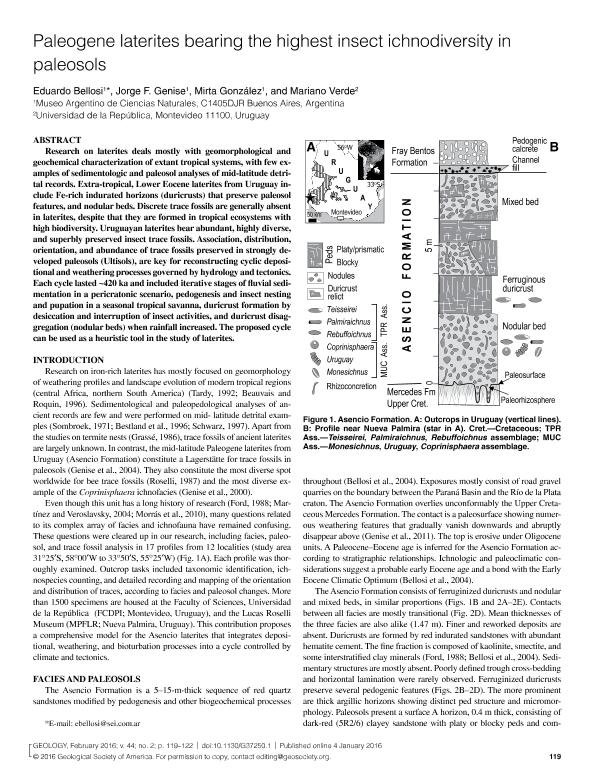Artículo
Paleogene laterites bearing the highest insect ichnodiversity in paleosols
Fecha de publicación:
01/2016
Editorial:
Geological Society of America
Revista:
Geology
ISSN:
0091-7613
e-ISSN:
1943-2682
Idioma:
Inglés
Tipo de recurso:
Artículo publicado
Clasificación temática:
Resumen
Research on laterites deals mostly with geomorphological and geochemical characterization of extant tropical systems, with few examples of sedimentologic and paleosol analyses of mid-latitude detrital records. Extra-tropical, Lower Eocene laterites from Uruguay include Fe-rich indurated horizons (duricrusts) that preserve paleosol features, and nodular beds. Discrete trace fossils are generally absent in laterites, despite that they are formed in tropical ecosystems with high biodiversity. Uruguayan laterites bear abundant, highly diverse, and superbly preserved insect trace fossils. Association, distribution, orientation, and abundance of trace fossils preserved in strongly developed paleosols (Ultisols), are key for reconstructing cyclic depositional and weathering processes governed by hydrology and tectonics. Each cycle lasted ~420 ka and included iterative stages of fluvial sedimentation in a pericratonic scenario, pedogenesis and insect nesting and pupation in a seasonal tropical savanna, duricrust formation by desiccation and interruption of insect activities, and duricrust disaggregation (nodular beds) when rainfall increased. The proposed cycle can be used as a heuristic tool in the study of laterites.
Palabras clave:
Paleogene
,
Laterites
,
Ichnodiversity
,
Paleosoils
Archivos asociados
Licencia
Identificadores
Colecciones
Articulos(MACNBR)
Articulos de MUSEO ARG.DE CS.NAT "BERNARDINO RIVADAVIA"
Articulos de MUSEO ARG.DE CS.NAT "BERNARDINO RIVADAVIA"
Citación
Bellosi, Eduardo Sergio; Genise, Jorge Fernando; Gonzalez, Mirta Gladys; Verde, Mariano; Paleogene laterites bearing the highest insect ichnodiversity in paleosols; Geological Society of America; Geology; 44; 2; 1-2016; 119-122
Compartir
Altmétricas




